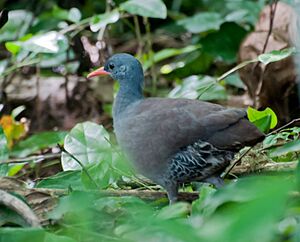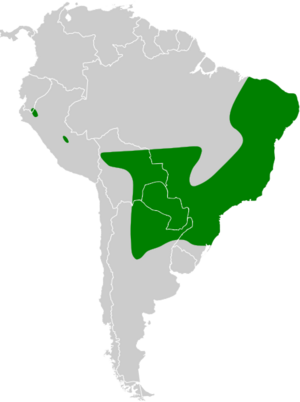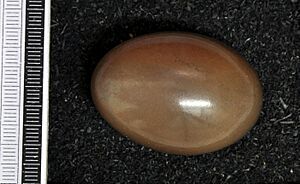Tataupa tinamou facts for kids
Quick facts for kids Tataupa tinamou |
|
|---|---|
 |
|
| In Piraju, São Paulo, Brazil | |
| Conservation status | |
| Scientific classification | |
| Genus: |
Crypturellus
|
| Species: |
tataupa
|
| Subspecies | |
|
C. t. tataupa (Temminck, 1815) |
|
 |
|
The Tataupa tinamou (Crypturellus tataupa) is a special type of bird called a tinamou. You can often find it in dry forests in warm, sunny parts of southeastern South America.
Contents
What's in a Name?
- The first part of its scientific name, Crypturellus, comes from old Latin and Greek words. It means "small hidden tail."
- The name Tataupa comes from the Guarani people. It describes the bird's gray, ash-colored feathers.
Bird Family: Tinamous
All tinamous belong to the bird family called Tinamidae. They are also part of a bigger group of birds known as ratites. Other ratites include ostriches and emus.
Unlike most other ratites, tinamous can fly. However, they are not very strong flyers. Scientists believe that all ratites came from ancient birds that could fly. Tinamous are the closest living relatives to these prehistoric flying birds.
Different Types of Tataupa Tinamous
The Tataupa tinamou has four different types, called subspecies. They live in different areas:
- C. t. tataupa: This type lives in eastern Bolivia, southern Brazil, northern Argentina, and Paraguay.
- C. t. inops: You can find this one in northwestern Peru, in the Marañón Valley. It also lives in the very southern part of Ecuador.
- C. t. peruvianus: This subspecies lives in west-central Peru, specifically in the Chanchamayo Valley of the Junín Region.
- C. t. lepidotus: This type is found in northeastern Brazil. It lives in the states of Bahia, Ceará, Piauí, Pernambuco, and Maranhão.
What the Tataupa Tinamou Looks Like
The Tataupa tinamou is about 25 cm (9.8 in) long.
- Its upper body is dark brown.
- It has a dark brown top of its head.
- Its throat is a pale gray color.
- The sides of its head, neck, and chest are a darker gray.
- Its belly is a light, yellowish-brown color.
- Both its beak and legs are a purplish-red color.
Behavior and Life Cycle
Like other tinamous, the Tataupa tinamou mostly eats fruit. It finds fruit on the ground or on low bushes. They also eat small amounts of insects, flower buds, soft leaves, seeds, and roots.
When it's time to lay eggs, the male tinamou takes charge. He will sit on the eggs, which might come from up to four different females. After the eggs hatch, he will raise the young birds. They usually stay with him for about two to three weeks until they are ready to live on their own.
The nest is built on the ground. It is often hidden in thick bushes or between the raised roots of trees.
Where They Live
The Tataupa tinamou prefers to live in dry forests. They can be found at heights up to 1,400 m (4,600 ft) above sea level. They also live in moist lowland forests and areas where forests have been changed by people.
This bird is originally from northeastern Brazil, eastern Bolivia, northern Argentina, Paraguay, and western Peru in South America. They have also been seen in the very southern part of Ecuador.
How We Protect Them
The IUCN (International Union for Conservation of Nature) says that the Tataupa tinamou is a species of "Least Concern". This means they are not currently in danger of disappearing. They live across a very large area, about 4,900,000 km2 (1,900,000 sq mi).



